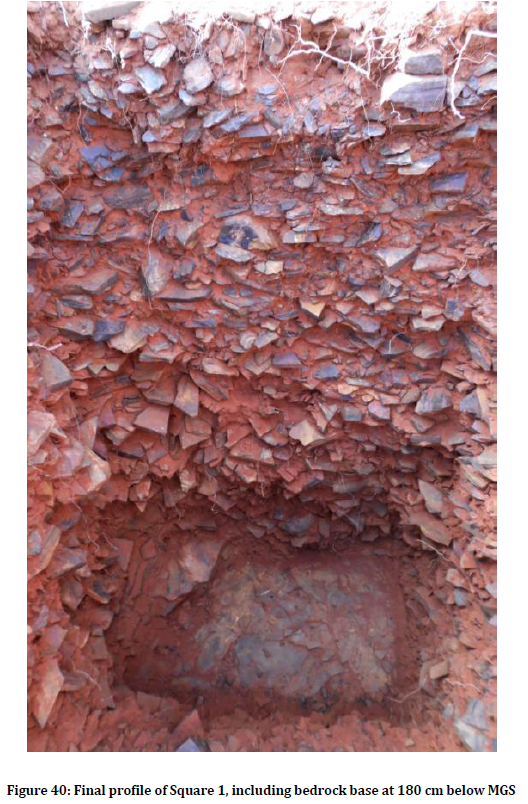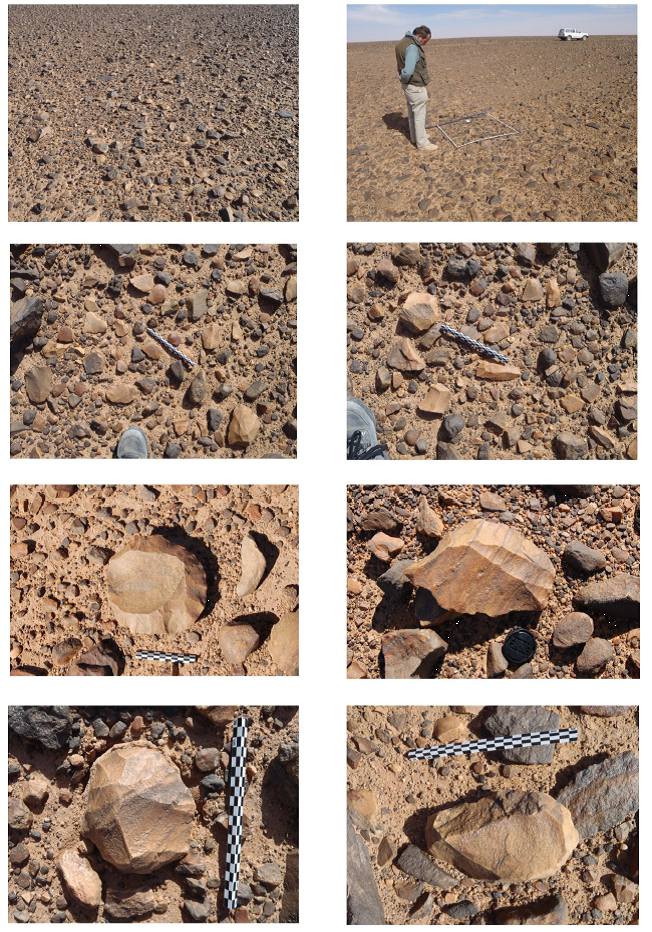The earliest stone tools could be as old as three million years, a number which while not even being 0.1% of the total age of the Earth is still a fantastically long length of time. Given that stone tools are extremely durable, one would expect a considerable volume of stone tools to be lying on the surface of the undisturbed parts of Africa as a direct result of millions of years of stone tool manufacture. Conversely, if the human race was only six thousand years old, then the volume of stone tools produced would be relatively small. Unsurprisingly, when we look at stone tool density in Africa, we find it to be far too high to be the result of only a few thousand years of human industry. We now have yet another line of evidence that directly refutes the assertion that the human race, and the Earth are only a few thousand years old.
EDIT: Joel Duff points out that there are problems with the original PLos ONE article and has emended his blog article accordingly. This post has been edited to reflect this. The conclusion however is not affected. Any YEC who argues otherwise has the burden of proof which involves considerably more than prattling about 'arithmetic errors' on a science denialist website.
There is a perception that stone tools are relatively scarce in the fossil record, but as professor of biology Joel Duff observed when commenting on a stone tool-rich site in Kathu, South Africa:When I first read about this incredibly rich stone tool site it got me wondering: just how prevalent are stone tools? I really didn’t know, but as I researched this site further and several others from around Africa and the Middle East I was absolutely stunned by the sheer volume of stone tools that have already been found. Then I asked myself the question, just how many stone tools or artifacts could there be in the soils of Africa? My back-of-the-envelope calculations seemed so ridiculously large that I am still not sure I can fully believe them.

A sample pit from Kathu Townlands Stone Age site. Stone Age artifacts are found throughout the column down to bedrock. The small rock pieces here are fractured bedrock from a hill nearby with wind blown in from the Kalahari dessert. Image from Walker et al. 2013 report: A second phase 2 archaeological data recovery at the site of Kathu Townlands for Erf 5116: Kathu, Northern Cape Province.
For example, the Kathu Townlands vacant lot site which was surveyed covered a couple of acres. In just that area alone I estimate there must be between 36 and 360 million artifacts. Those are astounding numbers. But then consider that large numbers of artifacts have been found outside this lot. The total area covered by this stone tool manufacturing center is now thought to extend over some 25 hectares (61 acres). Using much more conservative estimates for the density of artifacts and depth to which they occur, I still come up with an low-end estimate of 1 billion stone artifacts in these soils.
That's a huge quantity of stone tools in one area, and when one recognises that this is only in one part of Africa, it is easy to see that any YEC attempt to compress the stone age to fit within a few thousand years is unconvincing at best.
Things only get worse for YECs, as it turns out the earlier estimate of stone tool density was way too conservative, as Duff acknowledges in another article:
The results of a study just published (see references below) shows how incredibly dense stone artifacts can be in some places in Africa. Working in a remote location in southern Libya, researchers took surveys from hundreds of one or two-meter square plots. From the tens of thousands of artifacts found in them, they estimated a minimum density of 250,000 stone artifacts per square kilometer is present in this portion of Libya.
And this only included what was visible on the surface.
Figure C of the supplemental material from the paper by Foley RA, Lahr MM (2015) Lithic Landscapes: Early Human Impact from Stone Tool Production on the Central Saharan Environment. PLoS ONE 10(3): e0116482. doi: 10.1371/journal.pone.0116482. This shows the rocky landscape of southern Libya and the artifacts that are found in high abundance.
The researchers surveyed other published estimates of stone-tool densities in other areas of Africa. For example, some parts of the Nubian Desert average 12 million artifacts per square kilometer. They also calculate expected stone production given certain assumptions about population size and stone tool use over time. Overall, the researchers estimate that stone tool production across the entire continent of Africa has resulted in an average of 500,000 to 5,000,000 artifacts per square kilometer.
Africa is roughly 30 million square kilometers in area, so that would put the total number of stone artifacts between 15 and 150 trillion. Yes, that is trillion with a T—an astounding number.
Now these numbers may be a bit high but even if the authors overestimated the number of rocks several fold, it is clear that the number of rocks that have been manipulated by human hands that lie on or just under the surface of the African landscape is enormous.
The huge problem for YEC, as Duff notes, is that there simply not enough time in the YEC view for the volume of stone tools to be produced:
Yet here is what the YECs assume. A small band of people left Babel in 2250, migrated to Africa, forgot all the technology they once had in Mesopotamia, learned how to fashion rock into tools (this is a technology itself), extracted 40 million pyramid’s worth of rock from all over Africa, and fashioned that rock into countless numbers of stone tools in 150-500 years? Some YEC will doubtless claim that a group of 1000 people leaving Babel could have grown into a population of millions within 500 years and thus they could have produced several hundred billion artifacts. This still doesn’t get one to the observed numbers and that population growth would be unrealistic given the very difficult life of a nomad especially competing with lions and hyenas with only stone tools.And, remember, we are not even considering the billions of stone tools that exist outside of African in Asian and the Americas. Presumably people made their way to the Americas not long (10s of years maybe in the YEC timeline) after they came to Africa and yet the volume of stone tools in North America is a tiny fraction of what is observed in Africa.
Anyway, this group of migrants from Babel would have been small in number at first, and so it is not even reasonable to think they would have grown to 100,000 individuals by 2000 BC when they settled into an agricultural lifestyle and no longer needed to fashion stone implements. My estimate of 20 billion artifacts is incredibly generous, and yet it leaves the YECs exceedingly short of explaining the vast numbers of stone tools that are so easily observed.
The sheer abundance of stone tools in Africa is one of most devastating pieces of evidence against the young-earth hypothesis that I have encountered. Until I started looking at reports of stone artifacts in Africa I had no idea that stone tools were so ubiquitous. We see them in museums and tend to think they are very rare.
That pretty well wraps it up for YEC. Outside of invoking the explanation that God deliberately created the world covered with stone tools in order to create a fake human prehistory in order to test our faith, and that view of God as a wholesale deceiver is morally offensive, the only reasonable conclusion is that the Earth is considerably older than 6000 years, and hominins have been making stone tools for the best part of 3 million years.
We have an avalanche of evidence against both a young Earth and a young human race, but evidence such as this drives home the folly of the YEC viewpoint emphatically.
Joel Duff's blog Naturalis Historia is highly recommended for those wanting an informed, irenic examination of the intersection of science and Christianity.
